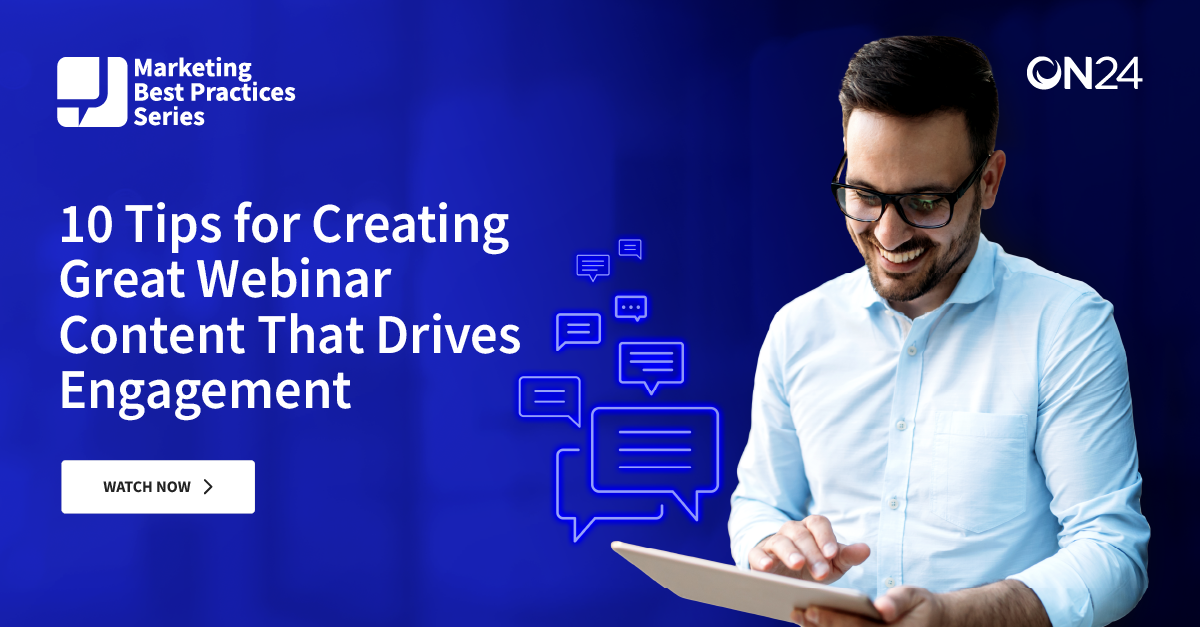What is a Webinar and How Do Webinars Work?

Webinars are one of the most indispensable weapons in a marketer’s armory. They provide an effective way to engage with potential attendees and prospective customers, delivering interactive experiences that go beyond simple online presentations. But what is a webinar, and how does a webinar work?
Behind even the most basic webinar, there’s a lot happening. When it comes to world-class solutions like the ON24 Intelligent Engagement Webinar Platform, the technology, combined with top-notch production capabilities, helps make the process of setting up and delivering webinar content seamless for webinar hosts.
Webinars differ from meeting tools designed for real-time team collaboration or internal all-hands meetings. They’re also distinct from traditional streaming media, which don’t offer the same level of attendee engagement or interactive features.
Webinar Definition
A webinar is a series of interactive, web-based events where a speaker-or multiple speakers-delivers a video presentation to a larger audience. Webinars have evolved to be a draw to attendees and a great opportunity for input from attendees through interaction with features such as polling, questions to the speakers, Q&A sessions and surveys.
Whereas standard webinars can be a bit drab, the more successful ones will have interactive features like screen share, session chat, even modal windows to enhance the experience for virtual attendees. This makes webinars ideal for educational presentations, product demos and even hybrid meetings with combined live and virtual elements.
Learn more about webinars:
- Going Bigger: How to Promote Webinar Marketing Events
- Taking In-Person Events Digital? Five Things to Consider
- 11 Excellent Questions for your Post-Webinar Survey
Even the most bare-bones webinar has separate streams for slides and audio. But most modern webinars go far beyond that, with slides, presenter video, integrated social media and live attendee feedback in the form of questions, polls, idea storming and more. And, with the power of generative AI, you can extract the valuable content in your webinars and leverage content repurposing to transform it into a variety of formats — from e-books and blog posts to video clips, summaries and more.
How Webinars Work
Webinars have become an integral part of modern corporate strategy due to the fact that they can engage and reach their audience better than ever before. From educationally inclined webinars to launching new products, they are considered one of the most effective and cost-effective methods to give out one’s message to target audiences all over the world.
A webinar typically includes one webinar host, presenters, and participants. With the use of webinar tools, hosts can present the content in real time or through pre-recorded webinars. Some webinars are purely educational, while others can be highly interactive, with tools such as polls, Q&As and screen sharing. This scope for interactivity makes webinars perfect for training sessions and user onboarding webinars, where participants get to ask questions and learn interactively.
Webinar Basics — How to Create a Webinar

To produce the best webinar experience possible, follow these five basic steps:
-
- Define your audience and consider their attendee journey.
- Brainstorm relevant topics that will drive audience participation.
- Create content — from deck slides to webinar scripts — for your presentation.
- Practice your material with your internal network and present it.
- Analyze the webinar event with event analytics to improve future webinars.
How to Prepare Webinar Content
The first step to preparing webinar content is understanding your audience. Whether they are potential customers, current customers, or part of a remote team, knowing their position in the attendee journey will shape your content.
Your marketing teams may want to focus on content marketing and email marketing campaigns to attract potential attendees. You can also use marketing automation platforms to streamline attendee registration and gather insights into attendee activity during the event. A strategic email marketing campaign can help boost attendance rates and lead to personalized digital experiences.
Is a Webinar Always Live?
No! Webinars can be live, simulive or on-demand. Each version has its own benefits to consider.
Many webinar recordings or on-demand webinars can accommodate busy schedules for those who cannot attend in real-time. You could pre-record a webinar and have your live audience communicate with you through Q&A chat or through an on-live session with visuals on the side during the playing of your prerecorded presentation.
Simulive webinars offer a recording capability coupled with live interaction, while on-demand webinars allow for the audience to consume at their own pace. Variety along these lines will help enhance both the virtual attendee experience and the numbers that attend sessions.
Pre-Recorded Webinars and Hybrid Events
Whereas live webinars provide the advantage of immediate interaction, with a pre-recorded webinar, you can let your audience consume information at their convenience, stuff that you have prepared well and smoothed out. This flexibility is really handy when, sometime in the future, webinars need to be viewed in different time zones or when consistency and quality need to be guaranteed.
Welcome to the era of virtual engagement, where hybrid events feature top-of-the-line live and pre-recorded webinars. These events combine dynamic live interaction with on-demand content for those who would rather engage on their own schedule.
ON24 Webinar Benchmarks

When is the best time to start promoting webinars?
According to our webinar benchmarks report, most attendees register either the week before the webinar launch (41%) or two weeks in advance (29%). Marketers should plan to start promotions over a three-week or longer time frame.
What is the average registration-to-attendee conversion rate?
Overall 53% of webinar registrants converted into an attendee. Of registrants, 35% converted as a live attendee and 23% converted as an on-demand attendee.
What’s the best day to send promotional emails?
In terms of driving registration, the best days to send promotional emails are Monday (21.7%), Tuesday (21.4%) and Wednesday (20.1%), with most attendees registering one to two weeks before the event. Your goals for email marketing should align with your marketing plans, ensuring that you engage both future attendees and those who missed out by offering access to recordings of interpretation sessions.
How many attendees can I expect at my webinar?
The average number of webinar attendees in 2022 was 188.
How long should a webinar be?
Audiences engage with webinars for an average of 55 minutes.
Learn more essential webinar statistics by downloading the ON24 2024 Digital Engagement Benchmarks and get a high-level look at the best practices that make webinars great. Download Now!
So, what are the most important factors of webinar technology? Let’s take a look:
Making the Webinar Presenter Successful

At ON24, we’ve spent years perfecting our presentation manager, PMXD. Obviously, we wanted to make it easy for you to upload, modify, manage and deliver your presentations. We quickly discovered that great webinar presentations take more than a well-uploaded presentation deck.
Most of our customers go into every webinar with at least two key players:
-
- The presenter delivers the webinar content.
- The producer handles all the behind-the-scenes work, like queuing video clips, managing guest speakers, and routing questions from webinar attendees.
Webinar Tips for Presenters
Before the webinar
Webinars have a lot of moving parts, so preparation is essential. Once you have a topic and an audience in mind, outline a presentation and draft slides. As you build your deck, look for opportunities to drive audience engagement through polls, surveys or Q&A.
Schedule a practice session with your finished deck, including anyone involved in the webinar — from presenters to producers and guests. Practicing identifies weak points and lets you adjust for better flow.
During the webinar
Start your webinars by guiding attendees through both the webinar console and the engagement tools included in the event. This way, attendees know how to interact with your event should they want to when prompted.
Run through your presentation as you normally would during your event, highlighting engagement opportunities (e.g., polls, surveys) as they arrive. If you’re running a Q&A session, your producer should select and prepare questions for the presenter to respond to.
After the webinar
Once your webinar event concludes, follow up with webinar recordings for both live attendees and those who missed the event. Turn your live event into an on-demand webinar and email a link to your registrants and attendees within 48 hours of the event ending. Use powerful analytics tools to track attendee engagement and improve future events. Post-webinar actions could include sharing blog posts, sending post-event surveys, or promoting the next online meeting to your wide audience.
Engagement doesn’t end when the live event finishes—leveraging webinar solutions to continue the conversation is critical. Whether your event featured a lively panel discussion, quick questions via dialog windows, or preloaded options for attendees, maintaining that engagement will drive further success.
Webinar Tips for Attendees

Before the webinar
As a webinar attendee, all you need to do is fill out a form to register for an event. Once registered, you should get an email with the details of an event, including a calendar invite.
Place the event on your work calendar and, on the day of the event, click the link to log in. Then, it’s just a matter of adjusting console windows as you see fit.
During the webinar
During the webinar, you’ll have the opportunity to interact with the host through engagement tools like Q&A, polls, surveys, certificates and downloadable resources. To access, or hide, these tools, simply click on the corresponding icon on the bottom row of the webinar console.
Other than that, sit back, relax and enjoy!
After the webinar
After the webinar ends, you should receive an email linking you to the on-demand version within a day or so. Click the link to enter the webinar.
We knew delivering live webinars can be stressful, so we helped the production team keep in touch with real-time chat and intuitive controls for controlling the webinar flow, pushing polls, and swapping out presentation content on the fly.
Providing an Engaging Webinar Experience

Engagement is what makes the ON24 webinar software stand apart. And we take that very, very seriously.
When you’re asking people to stare at their computer screens for up to an hour, you have to give them something interesting to stare at. It helps if you can also give them something interesting to do.
Most webinar software these days includes basics like a place to submit questions. But we don’t think that’s engaging enough. So, we’ve added popular interactive tools like surveys, polls, downloadable assets, and integrated social media. We’ve also created more niche widgets like idea storming, testing and certification tools and group chat.
But that isn’t where it ends. We also built a robust suite of integrations to make sure the data collected through all that interactivity is passed to your marketing automation and CRM platforms, creating a seamless marketing data environment.
Treating Always-on Webinar Audiences like Live Audiences

If you only consider the live audience, you aren’t taking the full picture into account. According to our webinar benchmarks report, more than 40% of webinar attendees only sign up for the on-demand event.
That presents an interesting challenge for us on the back end of webinar software. How will we treat all those people who, for whatever reason, just couldn’t make it to the live event?
Sure, treating on-demand webinars like static videos would be easier, but then your audiences wouldn’t get the full webinar experience. When we think about webinar engagement, we always consider additional viewers who watch webinars on-demand or simulive (pre-recorded webinars, then broadcast to a live audience at a designated time).
Every ON24 webinar, no matter how it’s delivered or when it’s viewed, must have all the bi-directional interactivity of a live webinar, from moving windows around the console to the ability to submit questions — and get an answer.
Hosting webinars has changed significantly over the past decade or so, and it’ll continue evolving as new technologies emerge. But for those of us who build the platform, the mission is always the same: to give you everything you need to engage an audience and meet your business goals.

